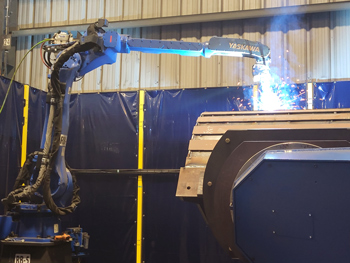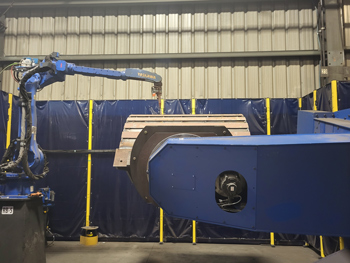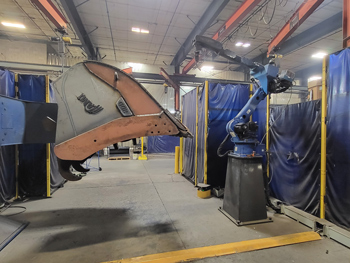With two decades in business, AMI Attachments (AMI) continues to apply proven expertise and provide long-lasting products that get the job done. A leading supplier of high-quality construction, mining, forestry and agriculture attachments, AMI unites innovative design and modern manufacturing with dedicated support to help customers thrive and be more competitive.
 The company’s state-of-the-art 100,000 sq. ft. manufacturing facility in Hawkesville, ON, Canada, implements next-level standards and high-performance materials, including Strenx® structural steel and Hardox® Wear Plate to produce reliable, efficient and durable attachments for excavators, backhoes, wheel loaders and other heavy construction equipment.
The company’s state-of-the-art 100,000 sq. ft. manufacturing facility in Hawkesville, ON, Canada, implements next-level standards and high-performance materials, including Strenx® structural steel and Hardox® Wear Plate to produce reliable, efficient and durable attachments for excavators, backhoes, wheel loaders and other heavy construction equipment.
Dedicated to excellence, AMI Attachments strives to offer the highest level of product quality and customer service to the industries it serves. As a result, weld quality and cycle time are key areas of focus on the production floor. To improve product throughput and address evolving demands for the heavy equipment attachment market across Canada and the United States, AMI leadership sought to improve takt time for the manufacturing of excavator attachments. To reach the necessary cycle time to achieve this goal – while maintaining the same high-quality standards for which customers are accustomed – it was determined that a new robotic workcell capable of welding a range of large, heavy parts for weldments up to two tons would be an ideal fit.
Solution
With other Yaskawa robots and workcells already installed on the factory floor, it made sense for AMI to standardize operations with another robotic workcell from Yaskawa Motoman. “Yaskawa provides us with the full package of what we require in our robot cells,” states Darren Bauman, Vice President of Operations for AMI. “This is something few companies offer, and it allows us to procure our equipment and have setup completed by one supplier, instead of many.”
Working directly through Yaskawa Canada, the chosen robotic solution features a single extended-reach AR3120 arc welding robot with integrated weld package that utilizes a Miller Auto-Continuum™ 500 EIP digital power source and an ABICOR BINZEL® ROBO WH 652 water-cooled torch with spare Binzel WHI 650. The ComArc LV “through-the-arc” seam tracking package with high-speed touch sensing function is also used, tracking the weld position and compensating for weld joint variation in real time for high precision welds.
 To facilitate fast, accurate and reliable rotation of heavy-payload parts, the workcell also includes a 3,000 kg payload capacity MT1-3000 skyhook tilt/rotate positioner that is calibrated to the robot for optimal robot travel speeds and the utmost weld quality. A Functional Safety Unit (FSU) provides safe operating zones for the robot and has the ability to limit operating range for improved safety.
To facilitate fast, accurate and reliable rotation of heavy-payload parts, the workcell also includes a 3,000 kg payload capacity MT1-3000 skyhook tilt/rotate positioner that is calibrated to the robot for optimal robot travel speeds and the utmost weld quality. A Functional Safety Unit (FSU) provides safe operating zones for the robot and has the ability to limit operating range for improved safety.
Due to the sheer size of equipment being welded, parts require the assistance of an overhead crane for loading and unloading. To accommodate this, a linear pass thru is configured into the workcell. This pass thru uses cascading light curtains for extra operator protection during the loading and unloading process, which takes approximately 20 minutes per load/unload. Fixture changeover, when needed, is not difficult, but it requires extreme caution and can take approximately 30 minutes, depending on the style of the attachment.
Results
“Since the workcell’s implementation in the fall of 2022, takt time initiatives have been met and production capacity has increased, improving the ability to ship higher product quantities and accept more customer requests,” continues Bauman. “Likewise, the workcell’s extended-reach robot, powerful skyhook positioner, robust welding package and seam tracking capabilities work together to produce consistent, high-quality attachments with less waste. The pressure of finding skilled welders to help meet on-going demands has also been alleviated.”
 Currently averaging 10 hours a day, 5 days a week, AMI is on track to reach the 36 month targeted payback period and plans to transition to two shifts in the near future, accelerating return on investment. Manpower investment is the same as before – with workers being retrained as robot operators or reassigned to other essential functions for optimal productivity gains. Only one operator is used for the workcell to clean and prep workpieces before and after the weld task to maintain fluid workflow, and fewer workers are required to flip large attachments to achieve the ideal welding position, maximizing AMI’s workforce while enhancing safety.
Currently averaging 10 hours a day, 5 days a week, AMI is on track to reach the 36 month targeted payback period and plans to transition to two shifts in the near future, accelerating return on investment. Manpower investment is the same as before – with workers being retrained as robot operators or reassigned to other essential functions for optimal productivity gains. Only one operator is used for the workcell to clean and prep workpieces before and after the weld task to maintain fluid workflow, and fewer workers are required to flip large attachments to achieve the ideal welding position, maximizing AMI’s workforce while enhancing safety.
For optimal uptime, offline programming via Delfoi’s PC-based offline programming platform is used. Including an extensive model library and built-in functions that facilitate safe, timely and cost-effective robot job creation, this convenient tool enables high-detail simulation. Moreover, it serves to build programming proficiency and a knowledge base that can cultivate maximum benefit from this workcell and others installed on the factory floor.
To ensure the utmost safety and ROI, five AMI employees completed the YRC1000 Basic Programming with Arc Welding course at Yaskawa Canada in Mississauga, Ontario. An accredited IACET (International Accreditors for Continuing Education and Training) facility, this training combined with thorough customer service through Yaskawa Support Services aided the successful integration of the robotic system for optimal uptime.
“The utilization of Yaskawa’s Basic Programming course has helped most of our team members pick up the basics of the teach pendant quickly, enabling each person to work independently with their designated robot after several months,” offers PJ Muker, Robotic Supervisor. This expertise, along with implementing the newest technology available, allows AMI to maintain the manufacturing of high-quality attachments with a progressive and modern outlook that sets them apart from their competition. Moreover, AMI’s success with robotics has become known to other high-mix, low-volume manufacturers, triggering international visits to AMI’s facility to demonstrate their utilization of offline programming and robotics – making them a role model for the industry.
Full case study article originally published in Canadian Fabricating & Welding.